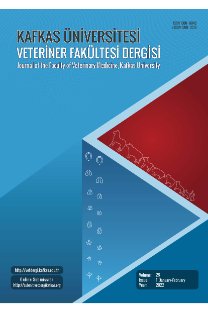Kuzularda üre-melas yalama bloğu ile beslemenin antioksidan sistem ve lipid proksidasyonuna etkisi
Doğu Anadolu Bölgesi, kuzu, üre, hayvan yemleme, antioksidanlar, lipit peroksidasyonu, serbest radikaller, saman, enzim aktivitesi, glutatyon peroksidaz, katalaz, albümin
Effect of feeding lambs with urea molasses licking block on the antioxidant status and lipid peroxidation
East Anatolia Region, lambs, urea, animal feeding, antioxidants, lipid peroxidation, free radicals, straw, enzyme activity, glutathione peroxidase, catalase, albumins,
___
- 1.Kılıç A: Türkiye'de kaba yem üretimi ve yeterlilik düzeyi, Türkiye I. Silaj Kongresill, İstanbul- Türkiye, 1997.
- 2.www.fao.org/ag/aga/agap/frg/afris/Data/557.HTM
- 3.Debasis D, Singh GP: Effect of cold process monensin enriched urea molasses mineral blocks on performance of crossbred calves fed a wheat straw based diet, Anim Feed Sci Technol, 03:(5l-6l, 2003.
- 4.Verma AK, Merha UR, Dass RS: Nutrient utilization by murrah buffaloes (Bubalus bubalis) as influenced by varying levels of urea molasses mineral block on wheat straw based diets, Anim Feed Sci Technol, 73:(339-346, 1998.
- 5.Hosamani SV, Merha UR, Dass RS: Effect of different planes of nutrition on urea molasses mineral block intake, nutrient utilization, rumen fermentation pattern and blood profile in Murrah buffaloes (bubalus bubalis) Anim Feed Sci Technol, 76:117-128,1998.
- 6.Srinivas B, Gupta BN: Rumen fermantation, bacterial and total volatile fatty acid (TVFA) production rates in cattle fed on urea-molasses-mineral block licks supplement, Anim Feed Sci Technol, 65:275-286,1997.
- 7.Toppo S, Verma AK, Dass RS, Merha UR: Nutrient utilization and rumen fermentation pattern in crossbred cattle fed different planes of nutrition supplemented with urea molasses mineral block, Anim Feed Sci Technol, 64:101- 112,1997.
- 8.Aarts G, Sansoucy R, Levieux GP: Guidelines for the manifacture and utilization of molasses-urea blocks. FAO Occational Publications, Rome Italy, 1990.
- 9.Windschitl PM: Lactational performance of high producting dairy cows fed diets containing salmon meal and urea, J Diary Sci, 74(10):3475-3485,1991.
- 10.Combellas J: The importance of urea-molasses blocks and bypass protein in animal production: The Situation in Tropical Latin America, Proceedings of International Symposium on Nuclear and Related Techniques in Animal Production and Health, Vienna, Austria, 115-132, 1991.
- 11.Jayasurita MCN, Smith T: Guidelines for developing feed supplemention packages. A manual for research and extension workers. IAEA, Vienna, Austria, 1997.
- 12.Hadjipanayiotou M, Verhaeghe L, Allen M, Kronfoleh, AR, Al Wadi M, Amin M, El-Said H, Al-Hares AK: Urea blocks. I. Methodology of feed block making and different formule tested in Syria. Livestock Res. of Rual Development, 5(3): 1-8,1993.
- 13.Ben Salem H, Nefzaoui A: Feed blocks as alternative supplements for sheep and goats. Small Ruminant Res, 49:275- 288, 2003.
- 14.Yun-Zhong F, Sheng Y, Guoyao W: Free radicals, antioxidants, and nutrition, Nutrition, 18: 10 (872-879), 2002.
- 15.Krajcovicova-Kudlackova M, Ursinyova M, Blazicek P, Spustova V, Ginter E, Hladikova V, Klvanova J: Free radical disease prevention and nutrition. Bratisl Lek Listy, 104(2):64-68, 2003.
- 16.Chandan K, Sen P, Lester P: Thiol homeostasis and supplements in physical exercise, Am J Clin Nutr, (suppl), 72:653-699, 2000.
- 17.Monte S, Willis Frank H, Wians Jr: The role of nutrition in preventing prostate cancer A review of the proposed mechanism of action of various dietary substances, Clin Chim Acta, 330:57-83,2003.
- 18.Nakai A, Oya A, Kobe H, Asakura H, Yokata A, Koshino T, Araki T: Changes in maternal lipid peroxidation levels and antioxidant enzymatic activities before and after delivery, / Nippon Med Sch, 67(6):434-439,2000.
- 19.Mert N, Gündüz H, Akgündüz V, Akgündüz M: Merinos melezi koyunlarda bazı biyokimyasal kan parametreleri ile verim arasındaki ilişkiler III-Glikoz, alkali fosfataz, seruloplazmin, Tr J Vet Anim Sci, 27: 583-588, 2003.
- 20.Beutler E, Duran O, Kelley BM: Improved method for determination of blood glutathion. J Lab Clin Med, 61: 882- 888, 1963.
- 21.Uchiyama M, Mihara M: Determination of malonaldehyde precursor in tissues by thiobarbituric acid test. Anal Biochem, 86: 271, 1978.
- 22.Aebi H: Catalase in vitro assay methods. Methods in Enzymology, 105:121-126, 1984.
- 23.Mansuy D, Dansete MP, Plat MA: New potent inhibitor of lipid peroxidation in vitro and in vivo. The hepatoprotective drug anisyldithiQlthione. Biochem and Biophys Res Com, 135 (3): 1015-1021. 1986.
- 24.Gutteridge JMC, Halliwell B: The measurement and mechanism of lipid peroxidation in biological systems. Trends Biochem Sci, 15: 129-135,1990.
- 25.Kleczowski M, Klucinski W, Sitarska E, Sikora J, Kasztelan, R: Influence of mineral nutrition on superoxide dismutase activity in blood of cows, Bull Vet Inst Pulawy, 47: 547-554,2003.
- 26.Freeman BA, Crapo JD: Biology of disease, free radicals and tissues injury. Lab Invest, 47(5), 412-425, 1982.
- 27.Cross EC: Oxygen radicals and human disease. Annals of Internal Medicine, 107: 526-45,1987.
- ISSN: 1300-6045
- Yayın Aralığı: 6
- Başlangıç: 1995
- Yayıncı: Kafkas Üniv. Veteriner Fak.
Kars bölgesi kistik ekinokokkozis
Kars ili kasaplık koyunlarında Linguatula serrata (Fröhlich, 1789) nimf' inin yayılışı
İstanbul' da evlerde beslenen köpeklerde Toxocariosis canis
Sütçü ineklerde beden kondisyon skorunun reprodüktif performans üzerine etkisi
Ruminantlarda yetersiz beslenmenin sindirimselve metabolik adaptasyonlar ve üreme üzerine etkileri
Yves CHILLIARD, François BOCQUIER, Mıchel DOREAU, ÖMER UÇAR, Yücel ÜNAL, Sedat YILDIZ
Kazlarda serum seruloplazmin ve total sialik asit düzeylerinin araştırılması
Koç spermasının farklı antioksidanlar içeren sulandırıcılarla kısa süreli saklanması
Kuzularda üre-melas yalama bloğu ile beslemenin antioksidan sistem ve lipid proksidasyonuna etkisi
AYLA ÖZCAN, ONUR ATAKİŞİ, SENA ÇENESİZ, Yücel ÜNAL
